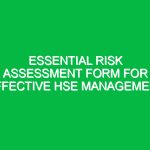Welcome and Introduction
Hello team! Today, we are gathering for this toolbox talk to address an essential topic that impacts each one of us: the importance of not taking Safety for granted in our workplace. Safety is not just a guideline; it’s a commitment we make to ourselves, our coworkers, and our families. As we dive into this discussion, I encourage you to think about your daily routines and how we can collectively create a safer work Environment.
Understanding the Concept of Safety
Safety in the workplace refers to the policies, procedures, and practices designed to protect employees from accidents, injuries, and Hazards. While many of us might feel we are well-versed in safety protocols, it’s crucial to remember that complacency can lead to dangerous oversights. When we take safety for granted, we risk our well-being and that of those around us.
The Dangers of Complacency
Every year, countless workplace accidents occur due to complacency. For instance, consider a scenario where an employee routinely uses a ladder without checking its stability. Initially, everything seems fine, but over time, the ladder wears down. Eventually, it may lead to a fall, resulting in serious injury. This example highlights how easily we can become complacent about safety protocols when we perceive that “nothing bad has ever happened.” We must remember that it only takes one moment of neglect for an accident to occur.
Real-Life Examples of Safety Oversights
Let’s look at a couple of real-life incidents to illustrate the consequences of taking safety for granted. In one case, a construction worker ignored the use of Personal Protective Equipment (PPE), believing their experience rendered it unnecessary. Tragically, they suffered a severe head injury from a falling object. This incident could have been avoided had the worker adhered to safety protocols.
In another situation, a manufacturing facility experienced a fire due to improperly stored flammable materials. Employees had become accustomed to the presence of these materials and ignored the established safety protocols for their storage. This oversight led to extensive property damage and endangered lives. These examples serve as stark reminders that safety must remain a priority at all times.
Why Safety Matters
So, why is safety so crucial? First and foremost, it protects lives. Every employee has the right to work in an environment free from Hazards. Moreover, a strong safety culture can lead to enhanced productivity. When employees feel safe, they can focus more on their tasks, knowing that their well-being is prioritized. Additionally, maintaining safety Standards helps avoid legal issues and potential fines for non-compliance with Regulations.
Key Components of Safety Culture
To foster a strong safety culture, we must understand its key components:
- Awareness: Every employee should be aware of potential hazards in their work environment.
- Training: Regular Training sessions should be conducted to reinforce safety protocols.
- Communication: Open lines of communication about safety concerns should be encouraged.
- Accountability: Everyone, from management to entry-level employees, should be accountable for upholding safety standards.
Identifying Potential Hazards
As part of our commitment to not take safety for granted, let’s discuss how to identify potential hazards in our workplace:
- Conduct Regular Inspections: Regular safety inspections can help identify potential hazards before they lead to accidents.
- Engage Employees: Encourage employees to speak up about unsafe conditions they observe.
- Review Incident Reports: Analyze past incidents to identify patterns and prevent future occurrences.
Best Practices to Enhance Workplace Safety
Now that we’ve discussed the importance of safety and the potential risks, let’s shift our focus to Best Practices that can help us maintain a safe work environment:
- Always Wear PPE: Never underestimate the importance of Personal Protective Equipment.
- Follow Procedures: Adhere strictly to established safety procedures and protocols.
- Stay Alert: Always be vigilant and aware of your surroundings.
- Participate in Safety Training: Engage actively in any safety training provided.
Encouraging Open Dialogue
As part of this toolbox talk, I want to emphasize the importance of open dialogue regarding safety. I encourage you to ask questions and share your experiences. What Safety Measures do you think we could improve? Have you witnessed a close call that we could learn from? Your input is invaluable in shaping our safety culture.
Regulations and Compliance
Understanding relevant regulations and compliance is crucial in the context of taking safety for granted. Regulatory bodies, such as OSHA (Occupational Safety and Health Administration), set forth standards that help ensure Workplace Safety. Compliance with these regulations is not just a legal obligation but a moral one. By adhering to these standards, we protect ourselves and our organization from potential legal issues and financial penalties.
Conclusion: Reinforcing Our Commitment to Safety
In conclusion, it is vital that we all commit to not take safety for granted. Safety is an ongoing process that requires constant attention, vigilance, and improvement. As we move forward, let’s apply what we’ve discussed today in our daily operations. Remember, a safe workplace is not just the responsibility of management; it’s a shared responsibility.
Thank you for your attention and for your commitment to fostering a safe work environment. Together, we can ensure that everyone goes home safe and sound at the end of the day.


